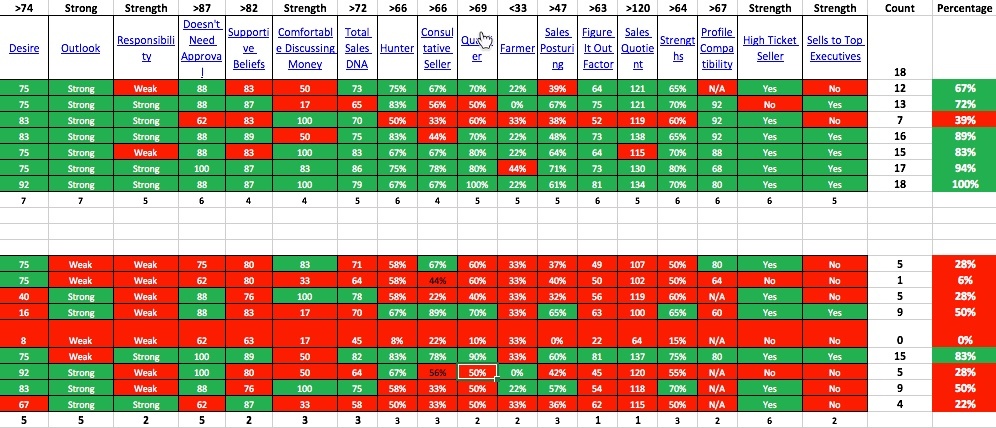- August 14, 2015
- Posted by: Dave Kurlan
- Category: Understanding the Sales Force

Today I received this email from an OMG (Objective Management Group) Partner after he asked me to run an analysis on a company’s top and bottom performers.
He wrote, “After all these years, this is still amazing to me. Thanks Dave, my conversation is Monday and we are getting next steps in place. Appreciate the help.”
So why is that such a big deal?
This is someone who has been an OMG Partner for nearly two decades, is one of OMG’s most successful partners, and knows our accuracy and sales-specific findings inside and out. And he was still surprised at just how accurate the analysis was. Check out the detailed and revealing graphic below!

I started with more than 100 sales-specific findings and narrowed them down to the 18 findings and scores that clearly differentiated their tops from their bottoms. A mistake made by behavioral scientists and sellers of personality and behavioral styles assessments is that they only look at top performers and identify common traits. They fail to realize that the bottom performers have the same personality traits and behavioral styles as the top performers and none of those traits or styles are predictive of sales performance.
In this company, the bottom performers scored just as well as the top performers on some sales-specific findings. To accurately identify salespeople that are totally perfect for a role, we must understand the differences between both groups, not the commonalities within one group.
The salespeople in the top 7 rows are their top performers and the salespeople in the bottom 9 rows are their bottom performers. After I identified the findings, scores and cutoffs that we would use, I color-coded them so that you could clearly see the differences – a sea of green on top and a sea of red on the bottom.
Next, in the last column on the right, I calculated the percentage criteria that each salesperson met and set the cutoff to 67%.
Using these criteria, we would have recommended 6 of their 7 top performers and only 1 of their 9 bottom performers. We would have been correct on 14 out of 16, or 88% which comes within a few percentage points of our usual predictive accuracy of 92%.
This is scientific sales selection. It’s a necessary part of an overall scientific approach to sales and the sales force.
What drives me crazy are the marketing people who are writing about sales despite their complete lack of understanding about B2B sales. They spin their messages to get business executives to think that the only thing that matters today is social selling, email, inbound marketing, and content. They hope that if they make inbound marketing sound easy enough by providing their tools and applications then businesses will buy their services and hire them. For instance, today I read that we no longer need sales process (untrue), a consultative approach to selling is dead (untrue), and all sales forces need to be completely restructured (generally untrue). That’s just today! And in the past 2 months, I have read that salespeople are now obsolete (untrue), prospects have completed 57% of their buying process before they meet with salespeople (the number is inaccurate) and people are no longer buying value (untrue).
There is no science backing up these claims, just a group of inbound marketers and an inside sales industry trying to convince you that sales today is is only about inbound and inside. It is true that low-price, low-cost, high-demand commodities that everyone wants – think B2C and subscriptions – are being sold almost exclusively via online marketing. But even some of those companies, like Hubspot, the King of Inbound, have large inside sales forces following a structured sales process and taking a consultative approach.
I’ve said this before, but it should be repeated. If you are not the price leader, market leader, or brand leader; if you have a new product, new technology, or a story to tell; if you have a long sales cycle, provide custom products, or have a design cycle; or if you are the underdog; you need salespeople, you need a custom, formal, structured, milestone-centric, customer-focused sales process, a consultative approach and skills that salespeople who came 10 years before you didn’t have. It’s a fact. And you can’t let Inbound Marketers, Social Sellers or Inside Sales gurus tell you otherwise. Don’t get me wrong. There is a place for inbound, social selling and inside sales in all of these companies. They are complimentary pieces, not replacements. After all, you wouldn’t replace a Quarterback with a Kicker – the Kicker is an important complimentary piece to a football team.
